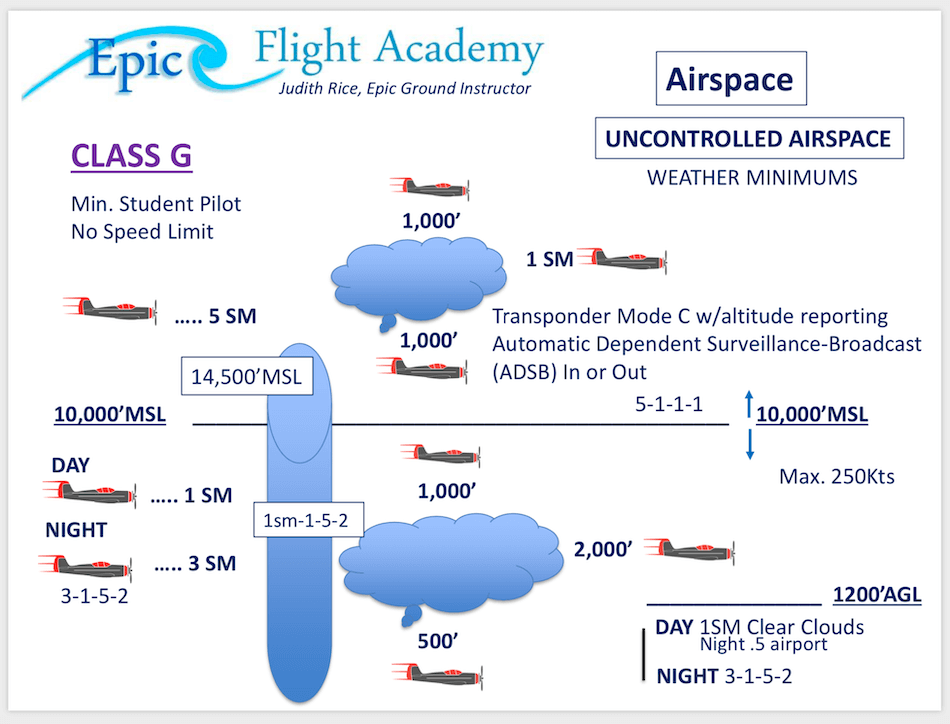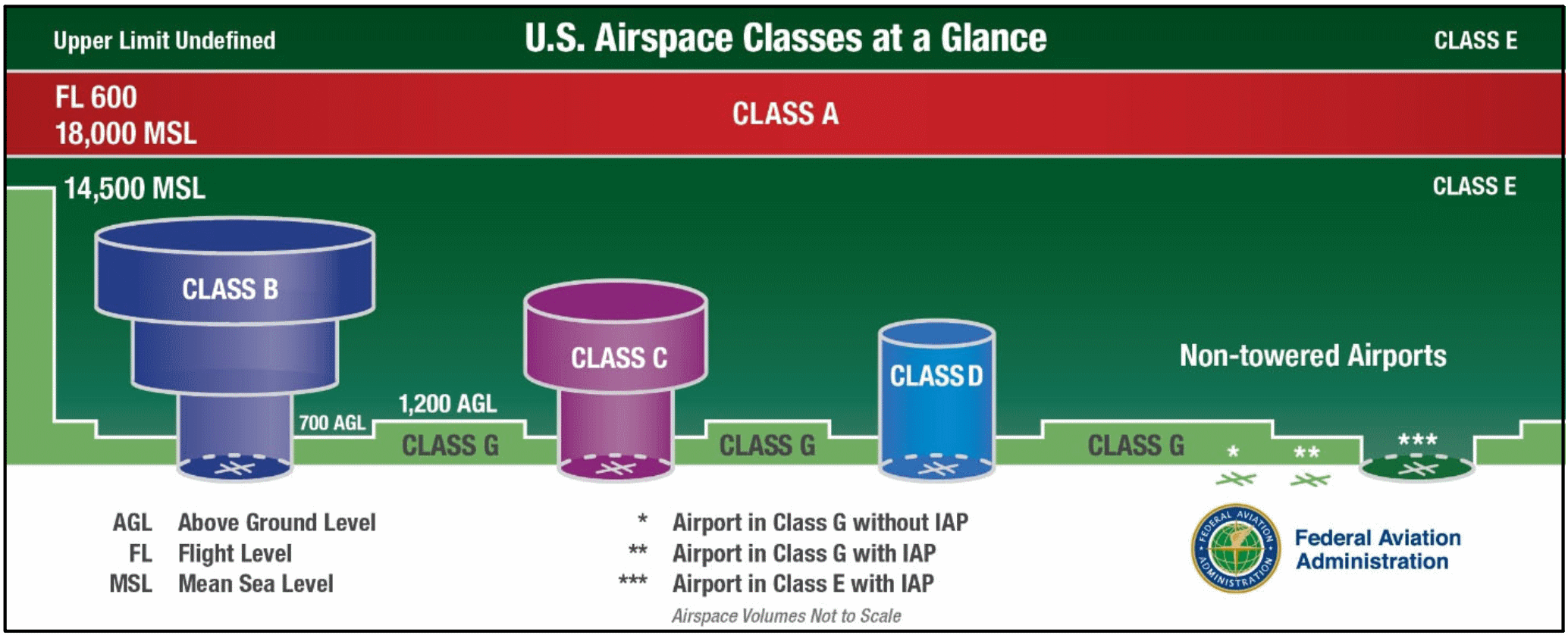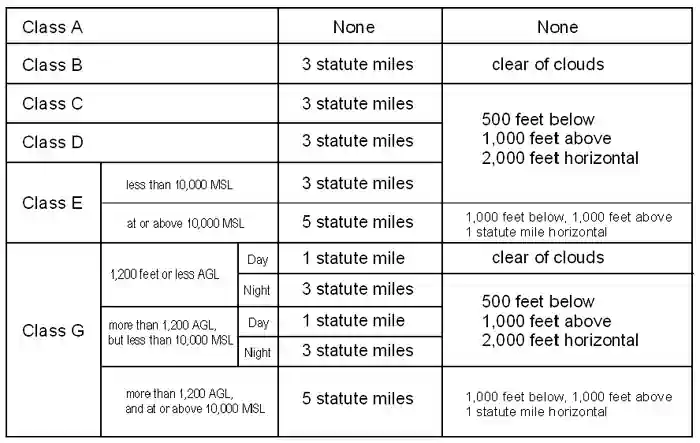class g airspace visibility requirements
Rules governing VFR flight have been adopted to assist the pilot in meeting the responsibility to see and avoid other aircraft. Notwithstanding the provisions of paragraph a of this section the following operations may be conducted in.
For Class B C D and E airspace below an altitude of 10000 MSL the basic VFR weather minimums are.

. For example if Class E starts at 700 feet AGL Class G goes up to but doesnt include 700 feet AGL. Above 1200ft stays at 1sm visibility but then for cloud clearance you must be 1000ft above 500ft below and 2000ft horizontal. And its always exclusive.
Airspace Requirements for Weather Minimums. Here VFR aircraft must maintain higher. Class C Airspace Class D Airspace Class E Airspace Class G Airspace.
Cloud clearance minimums of 1000 feet above 1000 feet below and 2000 feet horizontally. 14 rows Class G airspace will always start at the ground and go up to 14500 MSL as a. Daytime requirements for Class G are 1 statute mile visibility and clear of clouds to 1200ft.
Related Article Class G Airspace Explained. For example VFR flights are generally not allowed in Class A airspace so VFR visibility requirements do not exist for that class of airspace. 36 rows 2 If ground visibility is not reported at that airport unless flight visibility during landing or takeoff or while operating in the traffic pattern is at least 3 statute miles.
3 miles visibility 500 below 1000. In Class B airspace aircraft are required to remain. Visibility requirement 3 statute miles.
Above 1200 feet AGL but below 10000 feet MSL during the day. And Class E is more restrictive than Class G airspace. 1 SM visibility clear of clouds.
No person may operate an aircraft under basic VFR when the flight visibility is less or at a distance from clouds that is less than that prescribed for the corresponding altitude and class. This line shows enroute Class E airspace starting at. 1200 ft AGL or Below Day.
Basic VFR Weather Minimums. A Unless otherwise specified in the certificate holders operations specifications when conducting VFR helicopter air ambulance operations in Class G airspace the weather minimums in the following table apply. Of airspace and altitudes.
Although Class G is uncontrolled it is also subject to the most weather restrictions based on where the airspace is located. On a map Class Gs ceiling is the floor of Class E airspace. All operations in Class A Class B Class C and Class D airspace or Class E airspace designated for an airport must receive prior ATC authorization as required in 10317 of this part.
10000 feet MSL or higher. Posted June 16 2014. 1 mile visibility clear of clouds.
Distance from clouds requirement Clear of clouds. 1 statute mile visibility and clear of clouds. That means your weather minimums during the day are very lenient.
On the other hand Class G airspace has four different sets of altitude-dependent minimums. If you have trouble understanding which airspace an airport lies within check out our National Airspace System Training Course. The weather minimums in Class G airspace vary based on altitude whether it is day or night and proximity to an airport.
Minimum flight visibility and distance from clouds. VFR flight is based on the principle of see and avoid The presumption made in establishing the basic VFR weather minimums is that aircraft flying at lower altitudes ie below 10000 MSL andor in airspace. One mile visibility and clear of clouds is the daytime requirement.
Visibility requirement 1 statute mile. However within ½ mile of the runway or helipad of intended landing a helicopter may be operated in an airport traffic pattern clear of clouds if the. AIP ENR has the requirement of flight visibility for operating at or above 10000 feet at or above 10 000 feet different requirements are in place regarding the minimum flight visibility for aircraft flying under visual conditions see AlP ENR.
Class G airspace is most easily found on a sectional map when a fading thick blue line appears. Except when associated with a temporary control tower ATC does not have responsibility for or authority over aircraft in Class G airspace. However most regulations affecting pilots and aircraft still apply Pilots are reminded that in addition to IFR altitude or flight level requirements FAR 91177 includes the IFR requirement to remain at least 1000 2000 in mountainous.
Read More Airways System Airspace and Flight Services. At night less than 1200 AGL in Class G airspace the helicopter flight visibility requirements are 1 statue mile visibility and cloud clearance requirements are to remain clear of clouds. 12 rows No person may operate an ultralight vehicle when the flight visibility or distance from clouds is less than that in the table found below.
Class G Airspace Weather Visibility Requirements. Currently helicopters operating in Class G airspace under VFR and less than 1200 feet above the surface are required by 91155 1 to remain clear of clouds and to operate at a speed that gives the pilot adequate opportunity to see any air traffic or obstruction in time to avoid a collision. There are a few nuances here so pay attention.
Class G Uncontrolled Class G is considered uncontrolled airspace but still has VFR weather minimums. At night in Class G between 1200 AGL and 10000ft MSL the visibility and cloud clearance are the same as Class CD. 1200 ft AGL or Below Night.
1200ft or less above the surface regardless of MSL altitude Day. You can remember Class G uncontrolled airspace because its just like the good old days at the dawn of aviation. Class D airspace is more restrictive than Class E or Class G airspace.
Above 10000ft MSL the requirements are 5 SM visibility and cloud clearance of 1000ft above 1000ft below and 1 SM horizontally. Class G airspace uncontrolled is that portion of airspace that has not been designated as Class A Class B Class C Class D or Class E airspace. 135609 VFR ceiling and visibility requirements for Class G airspace.
Understanding the rationale behind the different requirements might help you remember them more easily. Airspace Flight visibility Distance from clouds. Here is what to know.
Above the Class G ground is Class E everywhere else and is controlled airspace. At night requirements jump to three miles visibility and from merely clear of clouds to 500 feet below 2000 feet horizontal and. E For the purpose of this section an aircraft operating at the base altitude of a Class E airspace area is considered to be within the airspace directly below.
The Walnut Ridge airport is in Class G airspace below 700 AGL with Class E airspace starting at 700. The requirements are slightly less restrictive in Class G airspace with a less restrictive daytime visibility below 10000 feet MSL 1 statute mile only and below 1200 feet AGL by day a less-restrictive separation from clouds clear of clouds with no distance-from-cloud requirements.

This Is How Class G Airspace Works Boldmethod
How To Remember Vfr Weather Minimums Bobbie Lind

Why Are There Mandatory Cloud Clearance Requirements Boldmethod
How To Remember Vfr Weather Minimums Bobbie Lind

Class G E Vfr Visibility Requirements Cheat Sheet I Made R Flying
Regulations Vfr Minimums Learn To Fly Blog Asa Aviation Supplies Academics Inc

Helicopter Instrument Procedures Part Three

Vfr Cloud Clearances Pilot Training For Ga

Faa Airspace For Vfr Flight Youtube

What Is The Minimum Flight Visibility And Proximity To Cloud Requirements For Vfr Flight At 6 500 Feet Ms Aviation Training Aviation Education Flight Training

Visual Meteorological Conditions Wikiwand

Airspace Classes And Special Use Airspace Everything There Is To Know

Airspace Classes Explained The Ultimate Guide For Beginners
How To Remember Vfr Weather Minimums Bobbie Lind

These Are 5 Of The Hardest Questions On The Faa Knowledge Test

